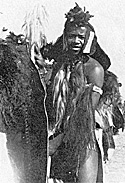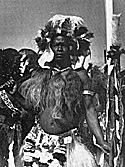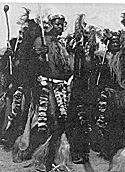 We have already taken a look, in issue one of The Courier, at firearms and the Zulu. Whatever their reaction to more recent imports, the Zulus were not short of a traditional armoury. Spears and shields were as old in Africa as the people themselves, and were by no
means as contemptible an array of weapons as the British troops of 1879 thought.
We have already taken a look, in issue one of The Courier, at firearms and the Zulu. Whatever their reaction to more recent imports, the Zulus were not short of a traditional armoury. Spears and shields were as old in Africa as the people themselves, and were by no
means as contemptible an array of weapons as the British troops of 1879 thought.
(1) & (2). An extraordinary pair of photographs, one of the few purporting to illustrate Zulu Warriors that can claim to be genuine. Taken sometime in the 1870s, it shows a warrior in full regalia front and back. Note the cowtails over the chest and back, the leopardskin headband and earflaps, fur skull cap and different feathers. Note, too, the lacing on the back of the shield and the handle to the left of the shield pole. Despite exhaustive investigation, it has not been possible to identify the regiment, although the lack of headring and predominantly black shield indicate an unmarried regiment. Photo by courtesy of Mr. S. Bourquin.
The Zulu word for a spear is umKhonto, though they are more commonly refered to by the European term assegai. Each assegai in Zululand had a specific name and purpose; the most famous of the fighting assegais was the iXwa (pronounced with a clicking sound on the 'X', which is difficult for the European palate to reproduce; often therefore spelt iKlwa).
This weapon was supposedly invented by the great warrior king Shaka himself. It had a short, stout heft, about 30 inches long, and a wide blade about eighteen inches long and two inches wide at its widest point. It was designed purely for use in close combat, as a thrusting
weapon, and called for a revolution in tactics.
Previously, Bantu armies had fought in loose mobs, hurling light throwing spears at each other, but Shaka introduced a ferocious shock tactic to enable his warriors to charge down on the enemy with their stabbing spears and, more often than not, obliterate them. It is a
sobering thought that the invention of the iXwa was more or less responsible of the extermination of several million people.
Throwing Spears
Throwing spears, isiJula, were the standard weapon in Zululand in pre-iXwa days. Shaka discouraged them in an attempt to further the use of his own innovation, but by
1879 they had made a wholesale reappearance and were widely used against the British. They had a shaft about three feet long and a slim, nine inch blade. Most warriors went into battle with a stabbing assegai and at least one or two spare throwing ones held behind the shield.
The shield, indeed, was the principle defensive weapon. In Shaka's day the shields were enormous, fully five feet long by three feet wide, and known as isiHlangu, 'brush Aside'.
(3). Reviving the spirit of his ancestors, a young Zulu warrior poses for his photo at the recent Centenary Celebrations in South Africa. Note the fine earflaps, both over the ears and over the shoulders. Photo by Knight.
A variety of other shields were used by the Zulu, for everything from dancing to courting, but the true war shield was the property of the state rather than the individual, and was issued from stores in the king's kraal at the mustering of the regiments with great ceremony. Thus it was possible to obtain a greater uniformity of shield design then is sometimes supposed; nevertheless most men would have carried a personal shield for their own protection, and
there would have been little uniformity in the colour and size of these.
Shields
All shields were made of an oval of stiffened cowhide. The hair was left on the outside, and
incorporated into the regimental uniform by means of a colour code; young, inexperienced regiments carried black shields, the amount of white on their shield increasing with experience until the most senior regiments carried all white shields.
The back of the shield was left its natural rawhide colour. A wooden pole ran the length of the shield from top to bottom, to act as a stiffener, and was held in place by strips of hide which were woven through slits in the shield itself, up one side, folded over the pole, and down the other. The lacing showed on the face and was usually arranged in contrasting colours. A piece of the lacing was slit on the back and made into a handle by which the warrior held the
shield, and the pole was often topped with a crest of golden civet fur or a cowtail plume.
When mustered for parade, the ceremonial regalia of the Zulu Regiments was quite spectacular. From puberty on the basic dress of every Zulu male was the umTsha, a thin leather belt with strips of fur hanging down in front and a piece of softened hide over the buttocks.
On special occasions the best furs would be worn and the hide at the back, the iBeshu, would hang almost to the knees. Some senior regiments wore the inSimba, or war kilt, over the umTsha. This consisted of strips of civet and monkey skin twisted
into tails and worn right the way round the waist to resemble a kilt. Bunches of cowtails, amaTshoba, were worn so as to obscure the body almost completely. They were worn from a thong around the neck so as to hang in a dense bunch almost to the knees at the back and as far as the waist over the chest. They were also attached to cords worn around the elbows and wrists, knees and ankles.
It's generally supposed, incidentally, that all cowtails worn were white; however, I was lucky enough to be able to visit South Africa earlier this year for the Centenary Celebrations, which included a parade by warriors dressed in traditional war garb. The amaTshoba were many and varied in colour, from dirty white to reddish brown and even black.
Headdress
It was in the headdress, however, that the distinctions marking one regiment from another were most obvious. Firstly there was the famed isiCoco or headring. Zulu warriors were not allowed to marry until the king gave his express permission, usually not granted until after a regiment had distinguished itself in combat. When a regiment was allowed to marry its warriors adopted the isiCoco as a sign of their new and enviable status. In itself it was an
animal sinew worn sewn into the hair itself, and polished with beeswax to a high glossy shine; well-bred Zulus kept the hair around the ring trimmed short.
The bulk of the headdress was worn from thongs around the head tied at the back and below the isiCoco in the case of married regiments. Each regiment had its own combination of feathers and furs, though they can be broadly divided into two types, married and unmarried. All warriors wore a headband of animal skinÄusually leopard for unmarried and brown otter for married--stuffed into a roll with dried cow dung or bull rushes, worn over the forehead and tied at the back of the head so as to leave the ends hanging over the shoulders like tails.
Ostrich feathers were worn by many regiments, both black and white. The long, eighteen inch tail feathers of the Sakabuli bird (Kaffir Finch) were worn in long, graceful bunches, mostly by young regiments, usually on either side- of the head, occasionally directly on top of it. Senior regiments wore single crane feathers over the forehead, and inDunas wore a bunch of Lourie
feathersÄ short, crinkly, bright red and flecked with greenÄat the back of the head.
Many warriors wore a skull cap of brown fur over the crown, and all wore earflaps of 'green
monkeyskin'. These hung below the headband in two shapes, either directly over the ears or at the back of the head over the shoulders, occasionally both. 'Green' Monkeyskin has usually been interpreted as the silvery grey skin of the Green Monkey, but when in South Africa recently a local expert explained to me that 'green' simply meant untreated! Whether this is strictly true I would not like to say, but certainly the warriors on parade during the Celebrations were 8 wearing earflaps in various natural colours.
Some unmarried regiments also wore a rather bizare item of headress known as amaPovela, which has been continually misrepresented in recent books on the subject. This consisted of two strips of hide, one on each side of the head above the temples, standing up stiff like horns. It was attached to the head by a band hidden under the headband, and the bottom ends of the uprights were visible as tabs showing beneath the headband. To the tips of
the uprights--the top, not half way up the sides as is usually shownÄ were attached cowtails, which fell back down over the head.
Attached?
Quite how much of this elaborate uniform, to which a great deal of prestige was attached, was actually worn into battle is a moot and oft argued point. Contemporary reports are incomplete and contradictory, ranging from one description of warriors 'stripped for fighting' to a reference to 'the crests of leopard skin and feathers, the wild oxtails dangling from their necks'.
My own opinion, based on a careful perusal of descriptions, photographs and the recent
Centenary Celebrations, is that this was largely a matter of personal choice. The warriors would disgard the more cumbersome items of their uniformÄthe Sakabuli feathers, for example, and
some of the cowtails--to leave a lighter regalia more suited to fighting. The headband, probably, would be retained, a few cowtails over the chest and around the limbs, perhaps the earflaps, and certainly any light feathers such as ostrich or crane.
To a certain extent wargamers will have to be guided by the whims of manufacturers on this,
since it will be they who decide which items to sculpt and which to discard. The conscientious, however, might be inclined to add items from filler or metal foil or trim them away with a sharp knife.
The following is a brief description of those regiments most prominent in the 1879 war. Being restricted in space I have listed only the best known regiments and have not bothered to list earflaps or cowtails with the uniforms, as they were common to the full dress of all regiments.
Nokenke Regiment
2,000 men in their early 30s, unmarried, commanded by umZilikazi. Leopardskin head band,
Sakabuli feathers on either side of head, black shields, occasionally with white spots.
umHlanga Regiment
1,000 men in their late twenties, unmarried. Leopardskin headband, black ostrich feathers
surmounted by several longer white ostrich feathers at front of head. Black shields with one white spot on lower half.
umXapo Regiment
1,000 men in their mid thirties, unmarried. Leopardskin headband, Sakabuli feathers, black and white ostrich feathers at front of head, black shields, occasionally spotted.
Ngwekwe Ngulubi or Mhlenivu Regiments
A total of 1,500 men in their mid 50s, married. Otter skin headband, two (sometimes only one) blue crane feathers either side of head. Shields white with black or red spots.
umKhulutshane Regiment
500 men in their mid sixties. Married, otterskin headbands, crane feather over forehead, white shields.
uDududu Regiment
1,500 men in their mid thirties. Unmarried. Otterskin headband, Sakabuli feathers hlack shields with white spots
Isanqu Regiment
1,500 married men in their mid fifties. Otterskin headband amaPovela, white shields.
uThulwana Regiment
1,500 married men in their mid forties, led in 1879 by the famous Dabulamanzi. Otterskin headband, Sakabuli feathers, Ostrich feathers at back of head (senior men had lourie
feathers), crane feather over forehead. Full kilt. Some senior men (not the majority) seem to have worn leopardskin capes. White shields.
inDlu-yengwe Regiment 1,000 men in their late twenties, unmarried. Leopardskin Sakabuli feathers, black ostrich feathers surmounted by white ostrich feathers
at front of head. Black shields with white spots on bottom half.
inGobamakhosi Regiment
6,000 strong, unmarried, in their mid twenties, led by uSicwelecwele. Leopard-skin headband, amaPovela, sakabuli feathers on either side of head, black, red, and black and
white shields.
uDhloko Regiment
2,500 married forty-year-olds led by uSibbephu.
Otterskin headbands, crane feather over forehead. Shields red with white spots.
umBonambi Regiment
1,500 unmarried men in their early thirties. Leopardskin headband, Sakabuli feathers on top of head, black and spotted shields.
umCijo Regiment
2,500 men in their late twenties unmarried. AmaPovela,
leopardskin headband, sakabuli feathers. Black shields.
uVe Regiment
3,500 unmarried men in their early twenties. Not yet given a uniform of their own they dressed as the inGobamakhosi.
Most of the above list comes from The Zulu Army a pamphlet prepared for the information of the invasion force in 1879 by border agent F. B. Fynney. A fuller list, based upon this and augmented with details from other sources, is available in the Victorian Military Society Zulu War Centenary Issue.
Further information on Zulu dress can be found in R. C. Samuelson's Long, Long Ago. Various fragmentary contemporary accounts, such as those in Frank Emery's The Red Soldier, shed further light on the matter, including my recent trip to Zululand was a great help.
Related
 In the 1850s, during the war in between Cetshwayo and his brother Mbuyazi, Cetshwayo introduced a new shield amongst his subsequently victorious uSuthu faction (whose name was taken into the language as the famous war cry). Called umBhumbhulosu, the new shield was lighter and easier to wield then its predecessor. It measured a uniform 3'6" long by 2' wide, and by 1879 was probably the more common.
In the 1850s, during the war in between Cetshwayo and his brother Mbuyazi, Cetshwayo introduced a new shield amongst his subsequently victorious uSuthu faction (whose name was taken into the language as the famous war cry). Called umBhumbhulosu, the new shield was lighter and easier to wield then its predecessor. It measured a uniform 3'6" long by 2' wide, and by 1879 was probably the more common.
 (4). Another photo taken at the Centenary Celebrations. Note the cowtails over the chest the complexity of the headress and the lush furs of the umTsha. Photo by Knight.
(4). Another photo taken at the Centenary Celebrations. Note the cowtails over the chest the complexity of the headress and the lush furs of the umTsha. Photo by Knight.
USIXEPI CORPS
UMBELEBELE CORPS
UMHLANBONGWENYA CORPS
 (5). Again, a recent photo, a reasonable impression of war dress notably lighter than that depicted in the contemporary photo. In the heyday of the Zulu empire, warriors went bare foot; their descendants are not so hardy! Photo by Knight.
(5). Again, a recent photo, a reasonable impression of war dress notably lighter than that depicted in the contemporary photo. In the heyday of the Zulu empire, warriors went bare foot; their descendants are not so hardy! Photo by Knight.
UDLAMBEDHLU CORPS
NODWENGU CORPS
UNDI CORPS
SOURCES
Zulu Firepower
Zulu Army Organization
Zulu Weapons and Uniforms
Native Levies in the Zulu War
Imperial Infantry Uniforms of the Zulu War
Zulu Roundup: Figures and Books
Back to Table of Contents -- Courier Vol. 1 #3
To Courier List of Issues
To MagWeb Master Magazine List
© Copyright 1979 by The Courier Publishing Company.
This article appears in MagWeb (Magazine Web) on the Internet World Wide Web.
Other military history articles and gaming articles are available at http://www.magweb.com